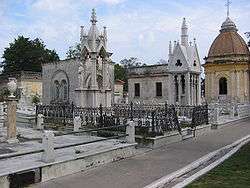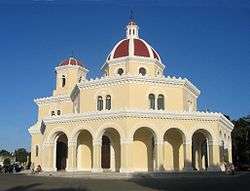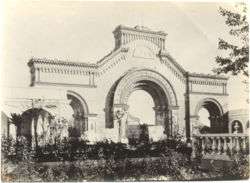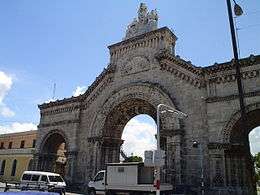Colon Cemetery, Havana
|
Main Gate (2007). | |
| Details | |
|---|---|
| Established | 1876 |
| Location | Vedado, Havana |
| Country | Cuba |
| Size | 140 acres (57 ha) |
| Number of graves | 800,000 |
| Number of interments | over 1 million |



The Colon Cemetery, or more fully in the Spanish language Cementerio de Cristóbal Colón, was founded in 1876 in the Vedado neighbourhood of Havana, Cuba on top of Espada Cemetery. Named for Christopher Columbus, the 140 acre (57 ha) cemetery is noted for its many elaborately sculpted memorials. It is estimated that today the cemetery has more than 500 major mausoleums, chapels, and family vaults.
Overview
Colon Cemetery is one of the great historical cemeteries of the world, and is generally held to be the most important in Latin America in historical and architectural terms, second is La Recoleta in Buenos Aires. It was built by the Galician architect Calixto Arellano de Loira y Cardoso, a graduate of Madrid’s Royal Academy of Arts of San Fernando, and who became Colón’s first occupant when he died before his work was completed. Yet for all its elegance and grandeur Colon Cemetery conceals as much as it displays. Empty tombs and desecrated family chapels disfigure the stately march of Cuban family memorials even in the most prominent of the avenues, and away from the central cross-streets, ruin. Many of these are the tombs of exiled families, whose problems with caring for their dead have been complicated by residence in new countries.
The first impact of Colon Cemetery is a seemingly endless succession of tombs blinding white in the midday heat, few shade trees and nowhere to sit. In front of the main entrance, at the axes of the principal avenues Avenida Cristobal Colón, Obispo Espada and Obispo Fray Jacinto, stands the Central Chapel apparently modelled on Il Duomo in Florence. On every side rectangular streets lead geometrically to the cemetery’s 56 hectares, designed by Loira to define the rank and social status of the dead with distinct areas, almost city suburbs: priests, soldiers, brotherhoods, the wealthy, the poor, infants, victims of epidemics, pagans and the condemned. The best preserved and grandest tombs stand on or near these central avenues and their axes.
Colon Cemetery has a 75-foot (23 m)-high monument to the firefighters who lost their lives in the great fire of May 17, 1890. As baseball is a leading sport in Cuba, the cemetery has two monuments to baseball players from the Cuban League. The first was erected in 1942 and the second in 1951 for members of the Cuban Baseball Hall of Fame.
In February 1898, the recovered bodies of sailors who died on the United States Navy battleship Maine were interred in the Colon Cemetery. In December 1899 the bodies were disinterred and brought back to the United States for burial at Arlington National Cemetery.[1]
Also buried here are three British Commonwealth servicemen who are commemorated by the Commonwealth War Graves Commission; a Canadian Army officer of World War I, and a Royal Engineers officer and Royal Canadian Navy seaman of World War II. The remains of the casualties are located in the mausoleum of the Anglo-American Welfare Association, with the names inscribed on the central memorial which also forms the entrance to the underground ossuary.[2]
With more than 800,000 graves and 1 million interments, space in the Colon Cemetery is currently at a premium and as such after three years remains are removed from their tombs, boxed and placed in a storage building.
Notable interments
- Santiago Álvarez (1919–1998), filmmaker
- Manuel Arteaga y Betancourt, Roman Catholic Cardinal
- Alberto Azoy (?–1952), baseball manager
- Beatriz Azurduy Palacios (1952–2003), filmmaker
- Hubert de Blanck (1856–1932), composer
- William Lee Brent (1931–2006), Black Panther Party member
- José Raúl Capablanca (1888–1942), world chess champion
- Federico Capdevila (?–1898), Lieutenant Colonel of the Spanish Army who defended the Cuban students of Medicine in 1871
- Alejo Carpentier (1904–1980), writer and musicologist
- Julián Castillo (1880–1948), baseball player
- Eduardo Chibás (1907–1951), politician
- Juan Chabás (1910–1954), author
- Ibrahim Ferrer (1927–2005), singer
- Candelaria Figueredo (1852–1914), patriot in the Cuban struggle for independence from Spain
- Carlos Finlay (1833–1915), physician and researcher
- José Miguel Gómez (1858–1921), president of Cuba
- Máximo Gómez (1836–1905), Dominican military hero
- Rubén González (1919–2003), pianist
- Nicolás Guillén (1902–1989), poet
- Nicolás Guillén Landrián (1938–2003), filmmaker and painter
- Tomás Gutiérrez Alea (1928–1996), filmmaker
- Harrison E. Havens (1837–1916), United States Congressman
- Alberto Korda (1928–2001), photographer
- Pío Leyva (1917–2006), singer
- José Lezama Lima (1910–1976), writer, poet
- Dulce María Loynaz (1902–1997), poet, novelist
- Dolf Luque (1890–1957), Major League Baseball starting pitcher
- Mary McCarthy Gomez Cueto (1900–2009), Havana socialite and musician
- Armando Marsans (1887–1960) Major League Baseball outfielder
- William Alexander Morgan (1928–1961), American adventurer
- Fernando Ortiz (1881–1969), ethnomusicologist
- German Pinelli (1907–1996), journalist, actor
- Chano Pozo (1915–1948), musician, pioneer of Afro-Cuban jazz
- Juan Ríus Rivera (1848–1924), Puerto Rican military hero
- Guillermo Rubalcaba (1927–2015), pianist and bandleader
- Lola Rodríguez de Tió (1848–1924), Puerto Rican poet
- Dr. Francisco Taquechel (1869–1955), notable doctor, founder (1898) and director of the Farmacia Taquechel, Old Havana
References
- ↑ Infos on spanamwar.com
- ↑ CWGC Cemetery report, details of dead from casualty record.
External links
| Wikimedia Commons has media related to Cementerio Cristóbal Colón. |
Coordinates: 23°07′23″N 82°23′55″W / 23.12306°N 82.39861°W
